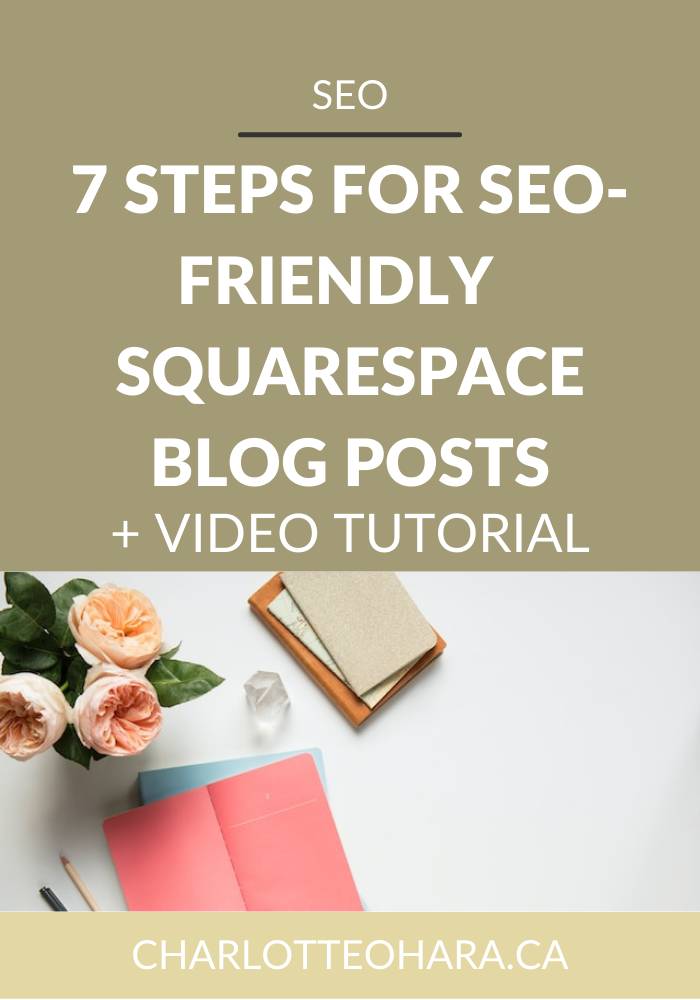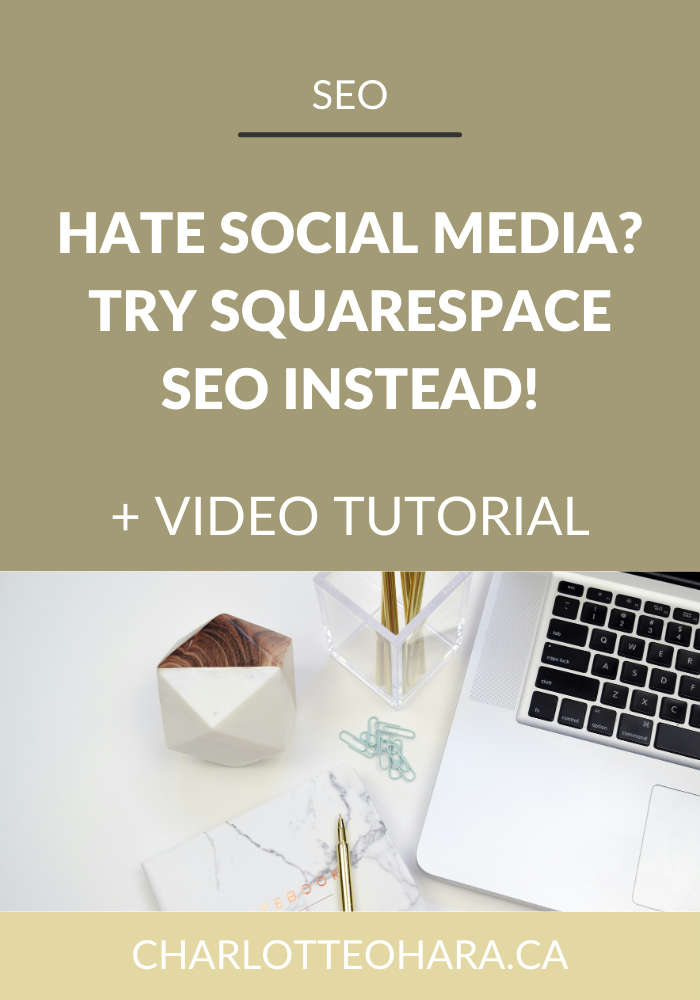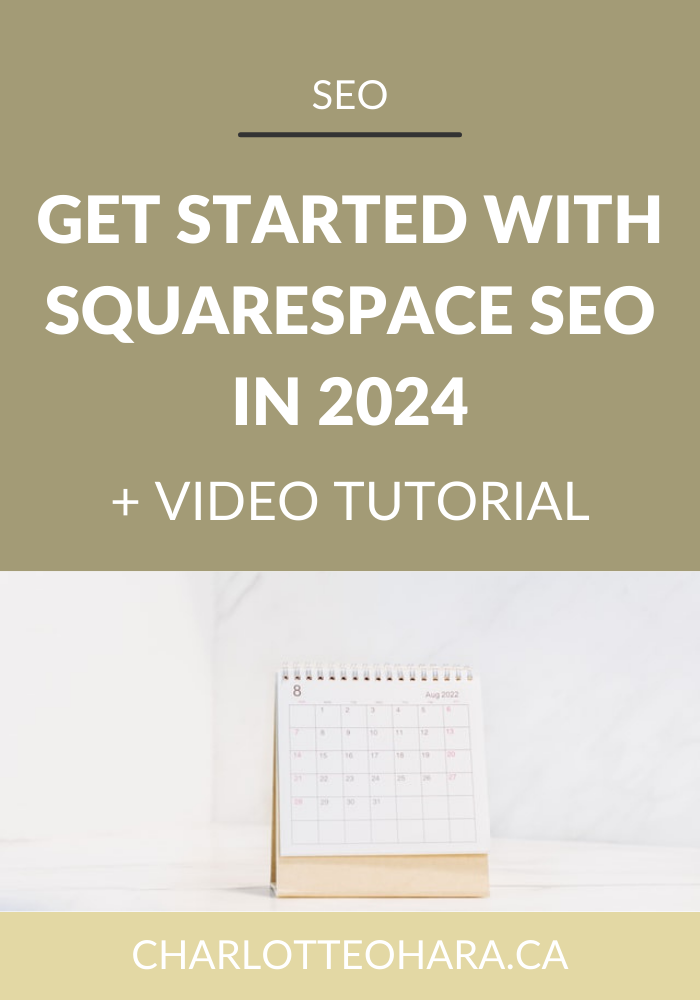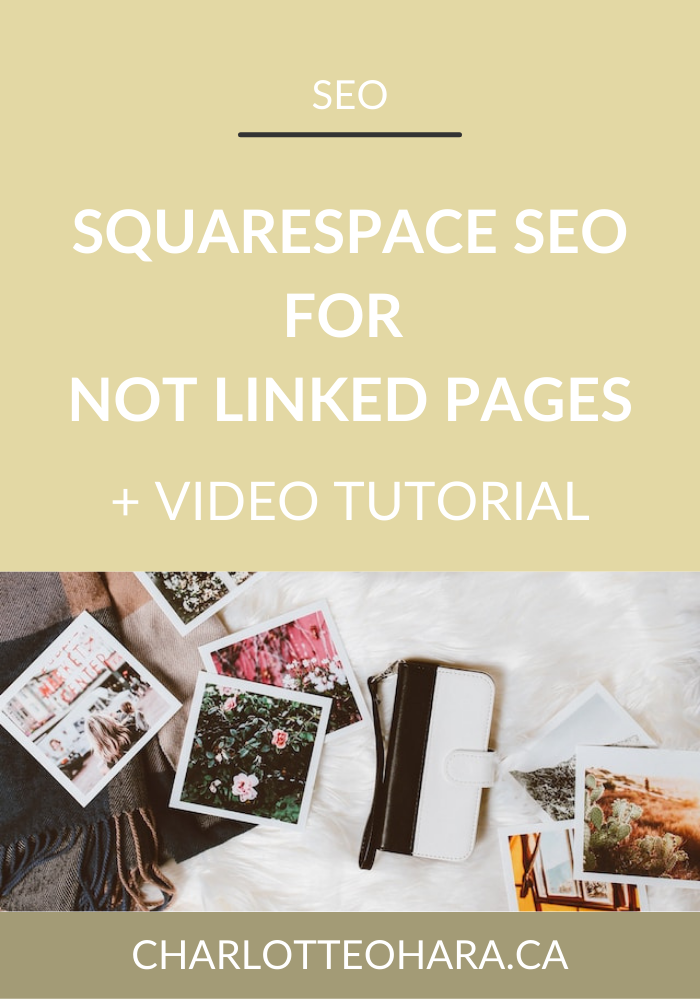7 steps for SEO-friendly Squarespace blog posts
Hellooooo SEOs, welcome back to another blog post all about… BLOGGING! Lol :)
In today’s post, we’re talking all about blogging on your Squarespace website, but we’re going to focus specifically on 7 things you can do to each blog post to make sure that it’s SEO-friendly!
Cause let’s be honest, no one wants to spend all their time & energy blogging… only to realize they didn’t do it properly and are missing out on all the juicy Google goodness.
Blogging is such a fantastic way to create website content that can show up in more online searches, drive more traffic back to your website, and help you reach even more of your potential clients & customers online.
Personally I LOVE blogging, because I think it’s really fun, but I also strongly recommend blogging to all my clients who are interested in/ concerned about Squarespace SEO.
Because truthfully, you’ll have a really tough time seeing major SEO results if you ignore blogging forever. Don’t shoot the messenger!
This is the kind of insider info that I give to my Squarespace SEO consulting clients and students in my signature online course, Top Squarespace SEO. But since I’m not one for secrets and truly want the best for anyone with a website, I’m giving you the goods here totally for free!
Oh, and I’ve even recorded a video tutorial for you to watch in case that’s more your vibe.
Enough chatting, let’s get right into it!
Related:
SQUARESPACE SEO SERIES
I have so many tips to share on the subject that it would have been crazy to put it all in one article! There are many misconceptions about Squarespace SEO which is why I've dedicate so many posts to this topic. Enjoy!
Work with Charlotte - explore my Squarespace SEO services & programs
7 steps for SEO-friendly Squarespace blog posts
Click play to watch the video!
Note: At the time of recording, this video shows my website on Squarespace version 7.0 . Your own website might look slightly different if your website is on Squarespace version 7.1 or a different 7.0 template, but the tips are still the same!
Step 1: Blog post title is clear, keyword rich and SEO-Friendly
Let’s start at the very beginning with your blog post’s title. This is the very first field you will fill out when you create a new blog post in Squarespace, and from here you can then move on to the rest of the content and blog post settings. On the front end of the website, once the blog post is published, you’ll see the blog post title at the very top of the post.
The blog post title should be three things:
super clear as to what the blog post is about
keyword rich (aka includes the main keywords/keyphrases for what the post is about)
seo-friendly
First off, I want you to think about the PERSON who will be reading this blog post. You should be creating this blog post with your ideal client/dream customer in mind, so if that’s the case then I want you to ask yourself “if my dream client reads this blog post title, will they be able to understand what it’s about? Is the blog post title descriptive and clear? Will they find it interesting enough to click through or read the post?”
Always think about the human on the other end of the screen first.
But at the same time, think about Google and how they will be crawling and indexing your blog post. If GOOGLE’s bot lands on your post and reads the blog post title, will it also be clear to Google what the blog post is about? Does the blog post title contain keywords or keyphrases, the same ones that are in the main blog post itself?
Fairly straightforward, once you understand what you’re doing here!
Step 2: Blog post contains lots of headers
If you take a look at any of my blog posts (this one, for example!), you’ll notice I use lots of headers throughout the body text of the blog post.
Headers are really helpful for people who might be skimming the blog post, reading through it quickly and looking for a particular section. If they see the headers, then they can easily find the content they are looking for (and will therefore stay on the blog post and not click away from your website) so it makes for a much better user experience.
Headers are also very useful for Google when they are crawling and indexing your blog post, which is why headers have an SEO consideration as well. Google will see the headers, review it and look out for any keywords/keyphrases, and generally have a better understanding of what the content of the blog post is about, what’s most important, what you’re trying to highlight to the reader, etc.
I recommend setting up your headers as Heading 2 and Heading 3 (H2s and H3s from the drop down text styling) and you can really use as many headers as you’d like.
Step 3: Long form content
One of the biggest tips I have for your when it comes to Squarespace SEO and blogging is that long form content is your BFF!
Take a look at my blog posts, for example - you’ll notice that I don’t shy away from writing a lot and I’m definitely not afraid of making the reader scroll LOL
Long form blog content might require you to play around with different formatting (headers! bullet points! numbered lists! bold! italics!) but I promise that’s not hard LOL and it will add lots of value while also making it easier for the reader to consume the blog post content.
Naturally, when you prioritize long form content, you will also end up including lots of keywords & keyphrases (which Google obviously loves to see!)
Long form blog content is the most impactful from an SEO point of view because Google will crawl and index the blog post and generally prioritizes long form content that is in depth, robust, answers all the potential searcher’s points related to the inquiry, and generally speaking does the best job of satisfying their online search.
It makes sense when you think about it: if Google has to choose between Blog Post A that is very short and only sort-of answers the question that the searcher asked, OR Blog post B which is much longer, covers everything the searcher needs to know (and more!) then obviously Google will present Blog Post B at the TOP of the search results…. which means that they get the lion’s share of the website traffic too.
So what does that mean for you, my beloved SEO hunni? It means that a short blog post is better than nothing BUT if you want the best results, then you should really be prioritizing long form content.
Think about your own blog posts for a second. Do you create blog posts that have long form content or are they just super short & tiny little posts? If Google were to land on your blog post, would they think it’s valuable enough to return in a search result (let alone at the top the search results)?
This applies to any new blog posts that you create in the future, but also don’t forget that you can always go back to old blog posts and update/improve them to make them longer and therefore more SEO-friendly (and competitive in Google’s eyes!)
Quality over quantity, hunni.
Step 4: Internal and External Links
Take a look at any of my blog posts and you’ll notice that I often include text links that might be useful to the reader. I do a combination of internal and external links, it just depends on what makes sense contextually.
I include these links all throughout the blog post: starting at the very top in the blog post’s introduction when I casually mention my services/ways to work with me and my signature program (Top Squarespace SEO). But I also link to any related blog posts, or places that I’ve explained something in greater detail already, where to sign up or join a program, helpful resources, anything like that.
Remember: the reason why I do this (and why you should do this too!) is obviously for a better user experience - I want my blog post reader to be able to easily access useful/relevant content on my website or elsewhere.
But in addition, you should remember that IF YOU HAVE BLOGGED CORRECTLY, your blog post will show up in online searches and people will be coming to your website for the very first time, via that blog post. As such, they haven’t seen anything else on your website yet so they don’t know about any of your amazing products/services/offerings yet.
When you mention all of this and link to it in the text, you are helping point them in the right direction, show them where to go next because obviously they haven’t explored your site yet.
Links help you to guide the blog post reader, offer them more value than what they might have expected when they first clicked over from a random Google search.
Internal links: links to other places on your website (different pages, blog posts, products, events, whatever)
External links: anytime to you link to another website (aka not your own website)
Both types of links are fabulous in their own way, and both are crazy valuable when done correctly, so I recommend that you add this step in to every blog post that you create!
Step 5: Tags & Categories
I’ve noticed that a lot of people DON’T fill out the tags & category fields on their blog posts (or anywhere else on their website tbh yikes haha) which is a dang shame because they are small details that pack a big punch!
For every blog post I create, I always spend the literally 1 minute to set up the tags & categories that makes sense for the post.
Tags & Categories are very helpful in terms of organizing blog post content and grouping together related posts by topic or some other notable feature/highlight.
Depending on how you’ve set your tags & categories to display, they might show up at the very top of the blog post on the front end (you can see this in action on my blog posts!). And then the reader can always click through those tags & categories links to see other blog posts that have been classified the same way which is cool for them if they are interested in that.
From an SEO point of view, tags & categories are also helpful to Google when they crawl and index the content because they can see how you’ve classified and organized the post and any keywords that you’re including in this way.
Related: Do tags & categories matter for Squarespace SEO?
Step 6 : Images
Take a look at most of my blog posts and you’ll notice that they’re created with lots of different TYPES of content:
text (what you’re reading)
a video (embedded from Youtube)
and images (screenshots, graphics, etc.)
Images are a really solid way that you can create different type of visual content but also help boost the blog post from an SEO-point of view.
BUT if you’re going to add an image to the blog post, don’t forget to name the image correctly! Think about what Google will “see” when they crawl and index the blog post and come to an image. Is it just something like “screenshot 1234” or has it been properly named with keywords so that the image is called “John Smith | Seattle Wedding Photographer | couple dancing outdoors at sunset under wedding arch” or something like that?
If you haven’t already, be sure to take a look at my Image Guidelines and Best Practices for Squarespace SEO or take a look at the MANY blog posts and Youtube videos I have that talk specifically about images and Squarespace SEO.
Related:
How to name the images on your Squarespace website’s SERVICES page for SEO
How to name the images on your Squarespace website’s ABOUT page for SEO
Step 7: fill out the SEO description for each blog post
Whether you’re blogging on Squarespace v 7.0 or 7.1, this is one step you should NEVER skip!
Once you have the blog post editor open, toggle over to the SEO tab and make sure that you fill out the SEO description field. Basically this is where you tell Google exactly what the blog post is about, giving an overview of the content and a summary of what the reader can expect. It’s a fantastic place to include keywords too, which Google will make note of when they crawl and index this setting of the blog post.
This SEO description field must be UNIQUE for each blog post - meaning you cannot just copy and past the same info and put it in each blog post!
If you want a refresher of how SEO description fields work, what to write and how to make sure they are keyword rich, then take a look at this blog post - Get started with Squarespace SEO - you can read the post and watch the video tutorial that goes along with it for a full demonstration.
Final Thoughts
Et voila, my friend - you now know the 7 steps for SEO-friendly Squarespace Blog posts. I’ve walked you through the steps to take to set yourself up for SEO success, given you demo’s of what to fill out and how, best practices to follow so that you have killer keyword-rich content, and you’re well on your way to becoming a blogging machine!
Do this for every blog post and you’ll see immediate results. Don’t forget you can always go back to old blog posts and update them to make them more SEO friendly, but at the very least keep these steps in mind moving fowrad with all the new blog posts you publish!
Try it out and let me know how things go!
xoxo
-Charlotte
Exciting news : my signature online course, Top Squarespace SEO, is open for enrollment and I’d love to have you join us inside the program! Learn all about it here.
If 1-on-1 is more your style, then I encourage you to sign up for my Squarespace SEO Audit & Consulting Sessions! We’ll hop on Zoom, make changes to your Squarespace website in real time, and you’ll get a totally personalized Squarespace SEO strategy to follow moving forward.
You can also sign up for my newsletter (right here or below), where I often share Squarespace SEO tips, tricks and high-quality exclusive content. I send out emails to my list a few days a week, mostly focused on Squarespace SEO, business and online marketing tips, and a behind the scenes look at what’s going on in my corner of the internet, and I can guarantee that you’ll find the newsletter topics interesting, entertaining and worth your time. #humblebrag
Finally, shameless plug: hit me up with any specific questions you have about Squarespace SEO and your website because I’m your girl. You can reach out to me directly if you’re interested in working together on your website and we can talk about whether or not you would be a good fit for my consulting and ongoing services. I can’t take on every request to do Squarespace SEO consulting but I do pick a few websites and businesses to work with every month and I’d love for you to be one of them.
You may also be interested in:
Top Squarespace SEO - online course details and enrollment













